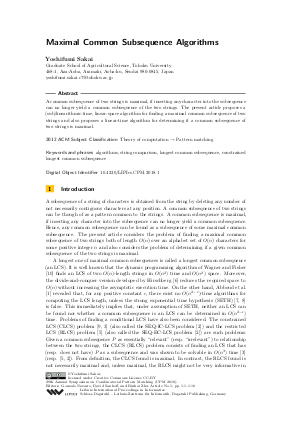Maximal Common Subsequence Algorithms
Author Yoshifumi Sakai
-
Part of:
Volume:
29th Annual Symposium on Combinatorial Pattern Matching (CPM 2018)
Part of: Series: Leibniz International Proceedings in Informatics (LIPIcs)
Part of: Conference: Annual Symposium on Combinatorial Pattern Matching (CPM) - License:
 Creative Commons Attribution 3.0 Unported license
Creative Commons Attribution 3.0 Unported license
- Publication Date: 2018-05-18
File

PDF
LIPIcs.CPM.2018.1.pdf
- Filesize: 434 kB
- 10 pages
Document Identifiers
Subject Classification
ACM Subject Classification
- Theory of computation → Pattern matching
Keywords
- algorithms
- string comparison
- longest common subsequence
- constrained longest common subsequence
Metrics
- Access Statistics
-
Total Accesses (updated on a weekly basis)
0PDF Downloads0Metadata Views
Abstract
A common subsequence of two strings is maximal, if inserting any character into the subsequence can no longer yield a common subsequence of the two strings. The present article proposes a (sub)linearithmic-time, linear-space algorithm for finding a maximal common subsequence of two strings and also proposes a linear-time algorithm for determining if a common subsequence of two strings is maximal.
Cite As Get BibTex
Yoshifumi Sakai. Maximal Common Subsequence Algorithms. In 29th Annual Symposium on Combinatorial Pattern Matching (CPM 2018). Leibniz International Proceedings in Informatics (LIPIcs), Volume 105, pp. 1:1-1:10, Schloss Dagstuhl – Leibniz-Zentrum für Informatik (2018)
https://doi.org/10.4230/LIPIcs.CPM.2018.1
BibTex
@InProceedings{sakai:LIPIcs.CPM.2018.1,
author = {Sakai, Yoshifumi},
title = {{Maximal Common Subsequence Algorithms}},
booktitle = {29th Annual Symposium on Combinatorial Pattern Matching (CPM 2018)},
pages = {1:1--1:10},
series = {Leibniz International Proceedings in Informatics (LIPIcs)},
ISBN = {978-3-95977-074-3},
ISSN = {1868-8969},
year = {2018},
volume = {105},
editor = {Navarro, Gonzalo and Sankoff, David and Zhu, Binhai},
publisher = {Schloss Dagstuhl -- Leibniz-Zentrum f{\"u}r Informatik},
address = {Dagstuhl, Germany},
URL = {https://drops.dagstuhl.de/entities/document/10.4230/LIPIcs.CPM.2018.1},
URN = {urn:nbn:de:0030-drops-87079},
doi = {10.4230/LIPIcs.CPM.2018.1},
annote = {Keywords: algorithms, string comparison, longest common subsequence, constrained longest common subsequence}
}
Author Details
References
-
Amir Abboud, Arturs Backurs, and Virginia Vassilevska Williams. Tight hardness results for lcs and other sequence similarity measures. In Foundations of Computer Science (FOCS), 2015 IEEE 56th Annual Symposium on, pages 59-78. IEEE, 2015.

-
Yi-Ching Chen and Kun-Mao Chao. On the generalized constrained longest common subsequence problems. Journal of Combinatorial Optimization, 21(3):383-392, 2011.

-
Francis YL Chin, Alfredo De Santis, Anna Lisa Ferrara, NL Ho, and SK Kim. A simple algorithm for the constrained sequence problems. Information Processing Letters, 90(4):175-179, 2004.

-
Campbell B Fraser, Robert W Irving, and Martin Middendorf. Maximal common subsequences and minimal common supersequences. Information and Computation, 124(2):145-153, 1996.

-
Zvi Gotthilf, Danny Hermelin, Gad M Landau, and Moshe Lewenstein. Restricted LCS. In International Symposium on String Processing and Information Retrieval, pages 250-257. Springer, 2010.

-
Daniel S Hirschberg. Algorithms for the longest common subsequence problem. Journal of the ACM (JACM), 24(4):664-675, 1977.

-
Russell Impagliazzo and Ramamohan Paturi. On the complexity of k-SAT. Journal of Computer and System Sciences, 62(2):367-375, 2001.

-
Russell Impagliazzo, Ramamohan Paturi, and Francis Zane. Which problems have strongly exponential complexity? Journal of Computer and System Sciences, 63(4):512-530, 2001.

-
Yin-Te Tsai. The constrained longest common subsequence problem. Information Processing Letters, 88(4):173-176, 2003.

-
Robert A Wagner and Michael J Fischer. The string-to-string correction problem. Journal of the ACM (JACM), 21(1):168-173, 1974.

-
Dan E Willard. Log-logarithmic worst-case range queries are possible in space Θ(N). Information Processing Letters, 17(2):81-84, 1983.

